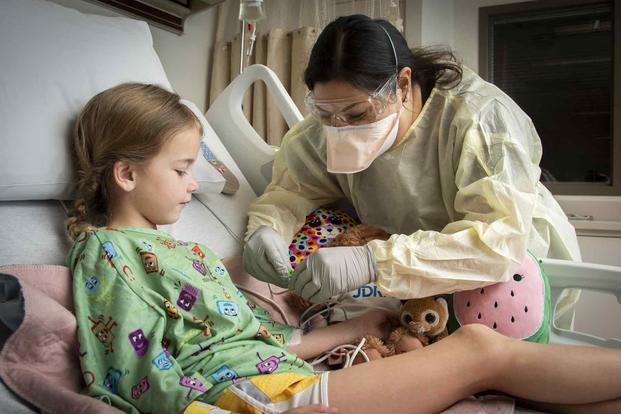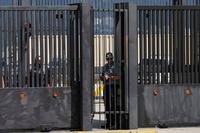The Defense Department is doing an about-face on a major component of reforms it launched seven years ago to reduce medical care costs, abandoning a plan to push family members and military retirees to private-sector care.
In a memo sent last month to senior Pentagon leaders, Deputy Defense Secretary Kathleen Hicks outlined an effort to "re-attract" beneficiaries to military hospitals and clinics -- at least 7% of those now receiving medical care through Tricare, the DoD's private health program, by Dec. 31, 2026.
Hicks said certain elements of the DoD's health system overhaul, which was mandated by Congress in 2017, have left military treatment facilities, or MTFs, "chronically understaffed" and unable to deliver timely care to all patients.
Read Next: Some Military Patients Left Without Heat for a Week at Texas Base During Blast of Frigid Weather
The goal for the new plan would be to review current staffing and potentially shift providers among facilities, or add new personnel as needed in order to provide improved access to care and bring back patients, according to the memo, provided Monday to Military.com by request.
In the memo, Hicks said the circumstances at military hospitals have not only affected beneficiaries, they have hindered providers, depriving them of opportunities to maintain their skills.
"Realignment of medical personnel, coupled with a challenging health care economy and ambitious private-sector care capacity assumptions, led to chronically understaffed [military treatment facilities] and [dental treatment facilities, or DTFs] that at times cannot deliver timely care to beneficiaries or ensure sufficient workload to maintain and sustain clinical skills," Hicks wrote.
The fiscal 2017 National Defense Authorization Act gave the Defense Department leeway in reorganizing the military health system to address rising costs and ensure the readiness of military health care providers to support combat operations and training.
As part of the reforms, management of the military services' 51 hospitals and 424 health and dental clinics shifted to the Defense Health Agency, which also was responsible for overseeing the massive plan to realign staffing at and consolidation of military health facilities while transferring an estimated 200,000 non-military beneficiaries to the Tricare network for private care.
Under the plan, the services were to cut roughly 12,800 military health billets, while the DHA would close or realign 50 facilities, including 38 that would serve military personnel only.
The DoD hoped that the consolidation and restructuring, which would require non-active-duty families to pay a larger portion of their health care costs, would curtail the military health system's now $54 billion budget.
Senior health officials said the reforms would be conducted so that patients still were able to access care within standards and, in some cases, have even better access.
But this did not prove to be the case.
In 2019, lawmakers began complaining that their military constituents were unable to get medical care in the private sector as a result of oversaturated markets and shrinking Tricare networks.
In 2022, evidence began emerging that staffing cuts at military health facilities and inflated estimates of the number of available physicians in civilian networks were affecting patient care in North Carolina, New York, the Pacific Northwest, California and Japan.
In some cases, patients drove an hour each way to receive quality care.
"We are really concerned about access to care overall, those within the direct care system and the purchase care system," said Eileen Huck, senior deputy director for government relations at the National Military Family Association, referring to the military and Tricare health systems, respectively, in an interview Tuesday. "We've been concerned about the erosion of the purchase care network, the lack of providers and specialties in some locations."
Hicks said the key to bringing patients back to military treatment facilities is building and staffing a dependable, high-quality workforce at these hospitals and clinics.
Under the plan:
- DoD must identify its military medical requirements -- including casualty care, combatant command and military department needs -- by July 2024.
- The under secretary of defense for personnel and readiness is to complete a comprehensive review of all medical manpower and staffing.
- The Defense Health Agency and the military services are to identify the capacity of each military treatment facility and the needs for military staff and civilian manpower by July 2024.
- DHA must be able to bring back at least 7% of beneficiaries to military treatment facilities on average by Dec. 31, 2026.
- The services and DHA must come up with a plan to realign staffing and prioritize assignments to ensure that facilities can take care of patients and support operational needs.
"Re-attracting and caring for more beneficiaries in MTFs and DTFs means that DoD needs to increase capacity and improve access," Hicks wrote. "To do so safely, MTFs and DTS must be staffed to provide quality patient care as well as career development, education and training opportunities for medical and dental personnel."
The effort to draw patients back to military treatment facilities echoes a major initiative launched a decade ago by Dr. Jonathan Woodson, then the assistant secretary of defense for health affairs, to attract patients to military treatment facilities in the waning years of the Iraq and Afghanistan wars.
For more than a decade, deployments of medical staff to combat zones made it difficult for many non-uniformed beneficiaries to get appointments at base hospitals and clinics, forcing them to seek care in their communities.
Citing data that showed direct care at military facilities cost about one-third less than Tricare purchased care, Woodson set a goal to ensure that base hospital usage reached 70% capacity.
At the time, some were running at just 33% capacity.
Woodson now serves as president of the Uniformed Services University of the Health Sciences, the Defense Department's medical school and research university, which, while not mentioned in the memo, would likely contribute to the new efforts given that the school is responsible for educating a portion of the U.S. military's physicians.
Karen Ruedisueli, director of government relations for health affairs at the Military Officers Association of America, remembered that effort and said MOAA is not opposed to the new emphasis on military-provided care -- if the DoD can ensure that the system has the capacity to take new patients.
"It's our concern that ... these folks are going to have trouble getting an appointment," Ruedisueli said. "We think there are a lot of question marks about what this looks like for military families."
She added that MOAA is advocating for beneficiaries to have a system for reporting problems, including access issues, with their health care to the DoD and have more flexibility in changing health plans.
Currently, beneficiaries can change plans only during open season or in a major qualifying life event, such as a marriage, divorce, birth of a child or move on military orders.
Ruedisueli said military families deserve more flexibility to choose plans, something that may be required if the Defense Health Agency wants to bring beneficiaries who use Tricare Select -- a flexible fee-based plan that lets beneficiaries choose their own doctors but does not let them use military treatment facilities -- back into those hospitals.
"The messaging has been for so long ... 'We're moving people out to the network,' which was all about readiness, and now, it's bringing people back in to support readiness, so there has been some whiplash for us," Ruedisueli said. "At the end of the day, there's still so many details we don't know."
Hicks said the department will move ahead with its plans to ensure that the U.S. military is medically ready to fight a war and all beneficiaries have access to care.
"Our service members, their families, other beneficiaries and all those cared for by military medicine will be better served when we rebuild MTF capacity," Hicks wrote.
Related: Denied Care, Deaths in Japan Result from Lack of Emergency Medical Services for American Personnel













